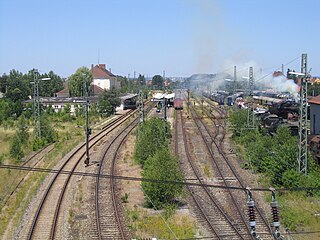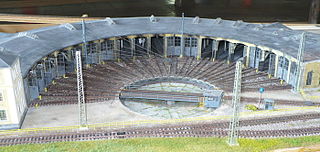

The Stoom Stichting Nederland (SSN) is a railway museum in Rotterdam, Netherlands, founded in 1976.


The Stoom Stichting Nederland (SSN) is a railway museum in Rotterdam, Netherlands, founded in 1976.
The SSN owns a motive power depot which includes a locomotive shed, in which major repairs can be carried out. A turntable, platforms and locomotive facilities also form part of the site. In the museum's engine shed, a large collection of steam locomotives from Germany and the Netherlands may be viewed. Several times a year special train services run throughout the Netherlands and may sometimes be seen in Germany too.
| Running number | Built | Manufacturer | Status |
|---|---|---|---|
| DRG Class 01.1075 | 1940 | Berliner Maschinenbau | working |
| DB Class 23 023 | 1952 | Arnold Jung Lokomotivfabrik | in overhaul |
| DRG Class 41 105 | 1939 | Friedrich Krupp AG | |
| DRG Class 41 241 | 1939 | A. Borsig, Berlin-Tegel | moved to VSM, Apeldoorn |
| DRG Class 50 1255 | 1941 | Arnold Jung Lokomotivfabrik | |
| DB Class 65 018 | 1955 | Krauss Maffei | taken out of service in November 2018 |
| Running number | Built | Manufacturer | Status |
|---|---|---|---|
| 6326 | 1914 | Orenstein & Koppel | working fireless engine, moved to STAR in stadskanaal in August 2017 |
| NS 8811 | 1943 | Hudswell Clarke Hunslet Austerity 0-6-0ST | three-axled shunter working |
Coordinates: 51°56′39.7″N4°30′26.3″E / 51.944361°N 4.507306°E

The British Rail Class 11 was applied to a batch of diesel shunting locomotives built from April 1945 to December 1952, based on a similar earlier batch built by the London, Midland and Scottish Railway (LMS) between 1934 and 1936.

The Bristol Harbour Railway was a standard-gauge industrial railway that served the wharves and docks of Bristol, England. The line, which had a network of approximately 5 mi (8.0 km) of track, connected the Floating Harbour to the GWR mainline at Bristol Temple Meads. Freight could be transported directly by waggons to Paddington Station in London. The railway officially closed in 1964.
The Saskatchewan Railway Museum is a railway museum located west of Saskatoon, Saskatchewan at the intersection of the Pike Lake Highway and the Canadian National Railway tracks. It is operated by the Saskatchewan Railroad Historical Association (SRHA) and was opened in 1990.

The Eisenbahnmuseum Bochum-Dahlhausen is a railway museum situated south of the city of Bochum in the state of North Rhine-Westphalia, Germany. It was founded by DGEG, the German Railway History Company in 1977 and is based in a locomotive depot that was built between 1916 and 1918 and ceased operation in 1969. Then DGEG took over the whole area of 46,000 square metres and built up the biggest railway museum in Germany. In the middle of the museum, there is an engine shed with fourteen tracks. A preserved turntable, coaling, watering, and sanding facilities are still in operation. This museum is integrated into The Industrial Heritage Trail a route of monuments from the history of the industry.

Southall Railway Centre is a non-publicised railway heritage centre at Southall in west London, near to Southall railway station and the Grand Union Canal. Formerly of the Great Western Railway the site is now run partly by Locomotive Services and West Coast Railways, both of whom lease the site from Network Rail. The location is not open to the public.

The Class S 3/6 steam locomotives of the Royal Bavarian State Railways were express train locomotives with a 4-6-2 Pacific or 2'C1' wheel arrangement.

The Bavarian Railway Museum is a railway museum based in the old locomotive sheds at Nördlingen station in Bavaria, Germany. It is home to more than 100 original railway vehicles and has been located in the depot at Nördlingen since 1985.

The Nuremberg Transport Museum is based in Nuremberg, Germany, and consists of the Deutsche Bahn's own DB Museum and the Museum of Communications. It also has two satellite museums at Koblenz-Lützel and Halle. The Nuremberg Transport Museum is one of the oldest technical history museums in Europe.

The Class 44 was a ten-coupled, heavy goods train steam locomotive built for the Deutsche Reichsbahn as a standard steam engine class (Einheitsdampflokomotive). Its sub-class was G 56.20 and it had triple cylinders. It was intended for hauling goods trains of up to 1,200 tonnes on the routes through Germany's hilly regions (Mittelgebirge) and up to 600 tonnes on steep inclines. They were numbered 44 001-44 1989.

The German Steam Locomotive Museum or DDM is located at the foot of the famous Schiefe Ebene ramp on the Ludwig South-North Railway in Neuenmarkt, Upper Franconia. This region is in northern Bavaria, Germany. The DDM was founded in 1977.

The Freilassing Locomotive World is a railway museum in the Berchtesgadener Land, which is operated with the cooperation of the town of Freilassing and the Deutsches Museum. The museum is located on the site of the former Freilassing locomotive shed which belongs to the Deutsche Bahn AG and houses part of the Deutsches Museum's railway collection. The second part of the collection is in the transport centre of the Deutsches Museum on the Theresienhöhe in Munich.

The German Class 41 steam locomotives were standard goods train engines (Einheitslokomotiven) operated by the Deutsche Reichsbahn (DRB) and built from 1937 to 1941.

The Dresden Transport Museum displays vehicles of all modes of transport, such as railway, shipping, road and air traffic, under one roof.

Coleford Great Western Railway Museum is a railway museum located in Coleford, Gloucestershire, England. The museum was founded in 1988. Based in the former GWR Goods Shed along the Coleford Railway. There was also another station situated at Coleford, it was opened by the Severn and Wye Railway. The Museum traces the history of all the railways in the Forest of Dean, Gloucestershire from the early 19th century when the first plateways were laid, to the 1970s when the Dean Forest Railway was founded. The Museum has information about the Wye Valley Railway, Severn & Wye Railway and Monmouth Troy railway station.

The South German Railway Museum is a railway museum at Heilbronn in the state of Baden-Württemberg in southwestern Germany. It was founded in 1998.

The steam locomotives of Class 23 were German passenger train locomotives developed in the 1950s for the Deutsche Bundesbahn. They had a 2-6-2 wheel arrangement and were equipped with Class 2'2' T 31 tenders. They were designed to replace the once ubiquitous Prussian P 8 engines that had been built between 1908 and 1924 and, in their day, were the most numerous post-war replacement class.

The AG Märkische Kleinbahn or MKB in Berlin is a German railway museum and heritage railway, founded in 1981, with legal status as a society since 1982. It has set itself the task of preserving historical railway vehicles and other items of railway technology in an operational state or for museum display and to make them accessible to the public. Their centre of operations is the locomotive shed at Schönow.

St Philip's Marsh depot is a railway depot located in the St Philip's Marsh district of Bristol, England. It was established as a steam locomotive shed in 1910 but this facility closed in the 1960s. A new diesel facility opened nearby at Marsh Junction in 1959). This has since been combined with a new shed which was opened in 1976 to maintain new InterCity 125 trainsets.

Train World is a railway museum in Belgium and the official museum of the National Railway Company of Belgium. It is situated in the preserved buildings of Schaarbeek railway station and in a new shed built to its north. Although scheduled to open in 2014, its opening was delayed until September 2015. The Museum was solemnly opened by King Philippe.

The Bocholt textile museum is a museum in Bocholt, a city in the north-west of North Rhine-Westphalia, Germany, part of the district Borken. It is situated 4 km south of the border with the Netherlands. The museum opened in 1989 as one of the eight locations of the LWL Industrial Museum: it is an Anchor point on the European Route of Industrial Heritage.